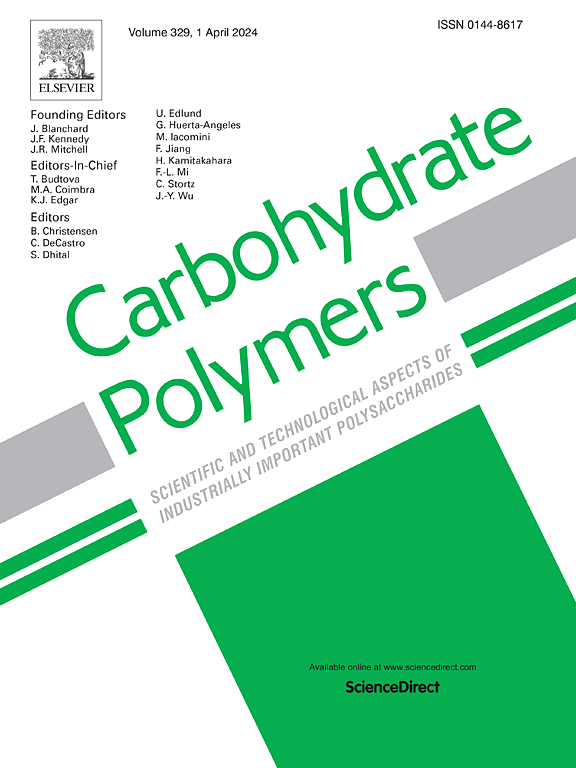鱿鱼和蟹壳壳聚糖理化性质及生物活性的比较分析
IF 12.5
1区 化学
Q1 CHEMISTRY, APPLIED
引用次数: 0
摘要
对从剑乌贼(squid gladius, CHS)和蟹壳(crab shells, CHC)中分离得到的分子量和去乙酰化程度相近的壳聚糖的理化性质和生物活性进行了比较分析。动态光散射(DLS)和原子力显微镜显示CHC在水溶液中形成聚集体的能力,而CHS产生更小、更均匀的结构。CHS的扫描电镜图像显示出均匀光滑的超分子结构,而CHC则表现出更多相的孔隙和空腔结构。CHC膜和CHS膜具有中等的吸湿能力,但在磷酸盐缓冲溶液中的水蒸气渗透性和溶胀率不同。DLS法和等温滴定量热法记录了不同来源的壳聚糖与聚阴离子κ-卡拉胶的相互作用特征。CHC和CHS对神经母细胞瘤细胞系Kelly和Lan-1均有轻微的抑制作用,对神经母细胞瘤细胞集落形成有抑制作用,其中对Kelly细胞系的影响尤为明显,对CHP-212细胞的影响最为显著。两种壳聚糖均能显著抑制复制缺陷病毒颗粒与HIV-1 (GP160)、水疱性口炎病毒(VSB-G)和Mus包膜蛋白的转导效率。caroli内源性逆转录病毒(McERV)本文章由计算机程序翻译,如有差异,请以英文原文为准。

Comparative analysis of physicochemical properties and biological activities of chitosans from squid gladius and crab shell
A comparative analysis of the physicochemical properties and biological activity of chitosans with similar molecular weights and degrees of deacetylation isolated from chitins of squid gladius (CHS) and crab shells (CHC) was conducted. Dynamic light scattering (DLS) and atomic force microscopy indicated the ability of CHC to form aggregates in aqueous solutions whereas CHS generated smaller and more homogeneous structures. Scanning electron microscopy images of CHS revealed a uniform smooth supramolecular structure while CHC exhibited more heterogeneous structures with pores and cavities. The CHC and CHS films showed moderate moisture uptake capabilities, differed in their permeability for water vapor and swelling rates in phosphate buffer solution. Chitosans from different sources displayed unique interaction features with the polyanion κ-carrageenan, as recorded by DLS and isothermal titration calorimetry methods. Both CHC and CHS exhibited mild inhibitory effects on neuroblastoma cell lines Kelly and Lan-1 and a suppressive effect on colony formation in neuroblastoma cells, particularly affecting the Kelly line and most significantly impacting CHP-212 cells. Both chitosans significantly suppressed the transduction efficiency of defective replication-incompetent viral particles with envelope proteins of HIV-1 (GP160), vesicular stomatitis virus (VSB-G), and Mus. caroli endogenous retrovirus (McERV).
求助全文
通过发布文献求助,成功后即可免费获取论文全文。
去求助
来源期刊

Carbohydrate Polymers
化学-高分子科学
CiteScore
22.40
自引率
8.00%
发文量
1286
审稿时长
47 days
期刊介绍:
Carbohydrate Polymers stands as a prominent journal in the glycoscience field, dedicated to exploring and harnessing the potential of polysaccharides with applications spanning bioenergy, bioplastics, biomaterials, biorefining, chemistry, drug delivery, food, health, nanotechnology, packaging, paper, pharmaceuticals, medicine, oil recovery, textiles, tissue engineering, wood, and various aspects of glycoscience.
The journal emphasizes the central role of well-characterized carbohydrate polymers, highlighting their significance as the primary focus rather than a peripheral topic. Each paper must prominently feature at least one named carbohydrate polymer, evident in both citation and title, with a commitment to innovative research that advances scientific knowledge.
 求助内容:
求助内容: 应助结果提醒方式:
应助结果提醒方式:


